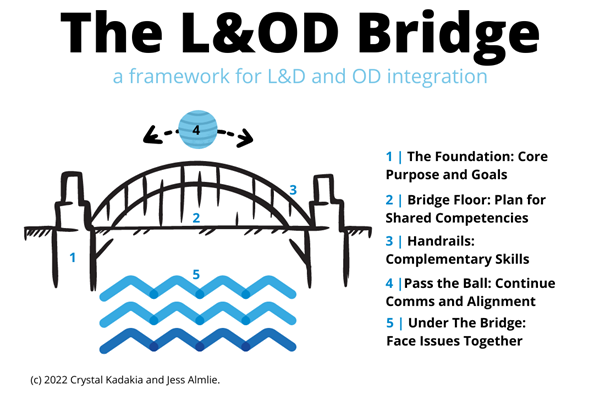ATD Blog
The Bridge Between L&D and OD Framework: The Foundation and the Floor
Tue Sep 13 2022

Bookmark
Last week, we asked how learning and development (L&D) and organization development (OD) can work together rather than in our own separate silos to make a bigger impact. We asserted that it is time to build a bridge between the two fields and began to lay the groundwork for the aptly named L&OD Bridge Framework. We explored the differences in our origin stories and how our differences shouldn’t divide us but should provide opportunities to bring us together.
With this insight into where our diverse thought patterns developed, we can begin to build. This week, we will dive into the first two of five steps to building our bridge: laying the foundation and creating the floor.

Step 1. Build the Foundation: Define a Common Core Purpose Based on a Business Pain.
Generally, when a stakeholder requests the involvement of L&D or OD in a project or initiative, it is because there is something that needs improvement. There is either an existing or forthcoming team, performance, or business problem that must be addressed. The stakeholder is looking for support outside of their team to solve that problem.
What if L&D partnered with OD (or vice versa) to plan an approach to the initiative? We suggest beginning with investigating a business challenge from both L&D’s and OD’s unique perspectives to identify the business’ pain points and possible solutions. Next, explore the “why” for each role’s involvement, and then articulate the findings as a common purpose for the project. Our bridge’s foundation relies on this essential anchor that we can return to as a project unfolds.
Investigating a business challenge cooperatively allows us to evaluate a stakeholder’s request thoroughly before presuming or jumping to a solution. Both L&D and OD have their own approaches to conducting a needs analysis that when combined provide a more thorough understanding of the business need. While stakeholders might have asked for training, we often know that training is not the full answer to a problem.
One way to jointly investigate the business challenge is to use the method offered by the Change On-the-Job Behavior Action of the Learning Cluster Design (LCD) model.
The Change On-the-Job Behavior Action of this model is distinct from other models because it creates a goal for a multi-asset learning or change initiative. The goal, or Strategic Performance Objective_,_ is unique because it outlines both the strategic business goals and the human performance goals all in one statement. The objective includes opportunities to brainstorm metrics for the initiative as well (and a later Action in the LCD model, Track Transformation, helps cement your measurement plan).
The LCD model was developed from both an OD and L&D perspective, and the needs analysis methods reflect the best of both worlds. The Change On-the-Job Behavior Action guides L&OD in how to ask questions of stakeholders to better define the business’ pain points and the on-the-job behaviors that are the targets for success. If you follow this approach or something similar, you will have everything you need to define a common purpose: goals at both the business and the individual level with metrics to target.
Once the objective is articulated, L&D and OD can thoroughly discuss the pain the business or the audience is experiencing and collectively determine what solutions are best delivered via learning experiences or organizational process and system changes.
Step 2. Build the Bridge Floor: Plan to Use and Build Shared Skills and Competencies.
Sometimes, L&D and OD should work together to advance an initiative, but we don’t. The floor of our bridge is built by jointly developing and using our shared skills and competencies in tandem. By making a simple shift to involve both teams and hold each other accountable for developing these skills, any project or initiative will emerge more robust; the deck of our bridge will be solid.
Some of the skills we should share and develop together to achieve our common goal of advancing and improving organizational performance include:
Internal Consulting Skills: Exercise curiosity by asking questions, and pair that ability with expertise to recommend solutions with our business partners for their benefit.
Business Acumen: Understand the overall business function including goals, revenue opportunities, basic workflows, current profit or loss status, team responsibilities, annual workload cadence, and decision making. Both L&D and OD benefit from a strong understanding of the business and can use that information to design effective interventions that stakeholders appreciate. The application of improved business acumen will build credibility and influence for practitioners in both fields.
Psychology of Change and Learning: Most interventions recommended or created by L&D and OD are designed to create a change within the organization. Whether revising an enterprise-wide process or focusing on upskilling one team, the goal is a change in behavior for a group of people. That means change partnered with a need to learn must occur. A better understanding of human behavior in response to change partnered with an understanding of implementing effective learning will be helpful to effectively guide an organization or team to make this change and create a lasting impact.
After defining the common purpose for the work, L&D and OD can create a plan for the project tasks they might work on together, such as brainstorming designs and analyzing data.
If L&D and OD share capability in certain models, the partnership can go a long way towards collaboration. For example, both teams can speak the shared language of design thinking, learning cluster design, or an agreed-upon theory of change for the organization.
Furthermore, in most change models, communication to drive awareness is a key step. This communication can be seen as a learning asset that L&D and OD collaborate on to create the most effective output. As another example, the LCD model asks practitioners to develop a new learning product that goes beyond formal training to include learning assets available on the job and through social means (a learning cluster). When L&D and OD are versed in this type of model, they can work together to move beyond one-and-done interventions to create a coordinated strategy for capability development.
What other skills could we advance together? How might you partner with OD further?
Steps 1 and 2 of our framework capitalize on our common ground. Next week, we will explore step 3, which finds the advantages inside of our differences.
More from ATD

